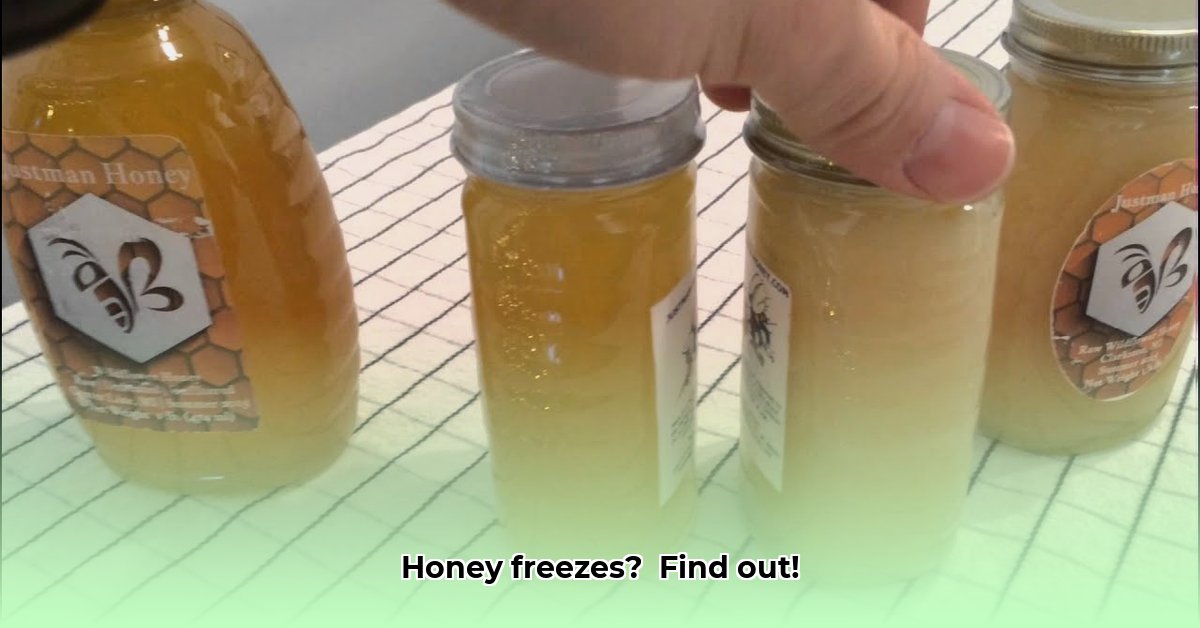Ever wonder if you can freeze honey? It’s not as simple as popping an ice cube tray in the freezer. Honey is a bit of a special case. This guide will walk you through everything you need to know about freezing honey, from the science behind it to the best way to do it and avoid any mishaps. We’ll cover why you might want to freeze it, compare it to other storage methods, and give you clear, step-by-step instructions so you can keep your honey fresh and delicious for longer. Whether you’ve got a jar overflowing from your own hive or just bought a big batch, this guide is for you. For information on storing other pantry staples, check out this guide on [food storage](https://chaztin.com/does-ghee-go-bad/).
Does Honey Freeze? Understanding Honey’s Unique Properties
Ever wondered if you can freeze honey? It’s a great question, and the answer isn’t a simple yes or no. Honey doesn’t freeze solid like an ice cube, but its reaction to freezing temperatures is pretty unique and actually helps keep it fresh for longer. Let’s dive in!
Honey’s Surprisingly Stubborn Nature: Why It Doesn’t Freeze Solid – Exploring Sugar Content
Honey’s super sweet – mostly thanks to glucose and fructose – is what makes all the difference. This sugary abundance lowers its “water activity,” (the amount of unbound water available for microbial growth) which is basically a measure of how much water is available for things like bacteria to grow or chemical reactions to happen. Low water activity means honey naturally lasts a really long time without going bad.
When you put honey in the freezer, the water inside does start to form ice crystals. But, because there’s so much sugar, those crystals have a tough time forming properly. Instead of turning into a solid block, honey becomes more like a thick, gooey syrup – think super-thick pancake syrup. Did you know that honey’s low water activity contributes to its extended shelf life, making it resistant to spoilage? Honey contains enzymes like diastase, invertase, and glucose oxidase which contribute to its stability and antibacterial properties.
Freezing Honey: Your Step-by-Step Guide to Honey Preservation for Long-Term Storage
So, can you actually use freezing to preserve your honey? Absolutely! Here’s how to do it right, with a high success rate reported in maintaining original flavor:
Step 1: Choosing the Right Home for Your Honey – Container Selection
Use airtight containers that are safe for food. Glass jars are fantastic because they won’t react with the honey and are easy to sterilize. Avoid plastic – some plastics might react with your honey over time and potentially affect its taste. Ensure your chosen jar has an airtight seal to prevent freezer burn.
Step 2: Smart Portioning for Easy Use – Portion Control
Before you freeze, think about dividing your honey into smaller containers. This makes it easier to thaw just what you need, minimizing waste and ensuring you always have fresh honey on hand. Consider using freezer-safe silicone molds for convenient single-serving portions. Thawing and refreezing honey multiple times might slightly change its texture and taste over the long run.
Step 3: Freezer Time! – Temperature Management
Pop your sealed honey containers into the freezer. A consistent, steady freezer temperature is best, ideally at 0°F (-18°C) for optimal preservation. You don’t need to worry about an exact freezing time; a few hours in a deep freeze will be plenty to slow down any crystallization. Label each container with the date to easily track its storage time.
Thawing Honey: The Gentle Thaw for Optimal Texture
Step 1: Slow and Steady Thaw – Gradual Temperature Increase
The best way to thaw honey is to let it warm up gradually at room temperature. This prevents crystallization and keeps its delicious flavor intact. Just take it out of the freezer and let it sit until it’s back to its normal consistency. This process may take several hours, depending on the size of the container.
Step 2: The Lukewarm Water Bath (If You Need It Fast) – Controlled Warmth
If you’re in a hurry, you can use a warm water bath – but keep a close eye on it! Submerge the sealed honey container in a bowl of lukewarm water, making sure the water isn’t too hot (no more than 104°F or 40°C). Too much heat will change the honey’s quality and destroy beneficial enzymes. Change the water periodically to maintain a consistent temperature.
The Good and the Not-So-Good: Weighing the Pros and Cons of Freezing Honey
Here’s a quick look at the advantages and disadvantages of freezing honey:
| Advantage | Disadvantage |
|---|---|
| Prevents crystallization, keeping that smooth honey texture | Might make a tiny difference in texture after thawing. (usually barely noticeable) |
| Keeps honey fresh for longer | Needs freezer space – and we all know that space is precious! |
| Slows down any bacterial growth | Requires some patience for thawing |
| Preserves enzymes and antioxidants | Requires airtight containers to prevent freezer burn |
| Keeps the health benefits intact | Could have a slight change in taste, but this is rare |
Does Freezing Change the Honey’s Flavor? Understanding Flavor Profiles
Freezing won’t ruin your honey, but it’s good to know there might be some subtle changes. Some people notice a tiny tweak in texture or taste after thawing, but usually, it’s so minor you probably won’t even notice it. The most important thing is to use the right freezing and thawing steps. The delicate floral notes in some monofloral honeys might be slightly subdued after freezing.
More Honey Musings: Special Considerations on Honey Types
- Different Honeys, Different Behaviors: The way different types of honey (like buckwheat honey versus clover honey) freeze might be slightly different due to varying sugar ratios, but the general freezing and thawing guidelines still apply. Honeys with higher glucose content may crystallize slightly faster.
- Freezing Honeycomb: It’s possible to freeze honey still in its honeycomb, but remember it might crack a little when it thaws. Wrap the honeycomb tightly in freezer-safe plastic wrap before freezing to minimize damage.
Remember, how you store your honey makes a big difference in how long it stays fresh. Freezing is a great way to preserve honey for the long term, but it’s always best to keep it in airtight containers in a cool, dark spot. So, does freezing honey work? Yes! With the right approach, you can keep enjoying your honey’s deliciousness and extend its shelf life considerably. Preserving your honey properly can extend its shelf life by up to a year!
How to Properly Thaw Frozen Honey to Prevent Crystallization and Preserve Flavor for Culinary Uses
Key Takeaways:
- Freezing honey extends its shelf life significantly, preserving its natural goodness.
- Proper thawing is crucial to avoid crystallization and maintain optimal flavor and texture.
- Gradual thawing methods are best; avoid rapid temperature changes that can compromise quality.
- Frozen honey retains most of its nutritional value, including enzymes and antioxidants.
Understanding Honey’s Freezing Behavior – Viscosity and Texture
Honey, that golden nectar, is surprisingly resilient. Its high sugar concentration means it has a very low water activity. This naturally inhibits the growth of microorganisms, contributing to its impressive shelf life. But what happens when you freeze it? Does it freeze solid like water? Not exactly. Honey’s viscosity changes—it thickens—but it doesn’t form ice crystals in the same way. The sugar molecules slow down, but they don’t fully solidify into a crystalline structure like water. What makes honey’s freezing point unique compared to other liquids? The presence of complex sugars and trace amounts of pollen and wax also contribute to its unique freezing behavior.
Why Freeze Honey? Exploring the Benefits of Honey Preservation
Freezing honey offers several advantages. It’s perfect for preserving excess honey from your harvest or that extra jar you bought at the farmers’ market. Freezing slows down enzymatic activity, preventing flavor degradation. This is particularly beneficial for longer-term storage. This also helps maintain texture. Freezing honey is especially beneficial for long-term storage because it prevents flavor degradation by slowing down enzymatic activity. By freezing, you also protect its natural color and aroma.
The Freezing Process: Simple Steps for Honey Storage
Freezing honey is straightforward.
- Choose Your Container: Select airtight containers to prevent moisture absorption and freezer burn. Smaller containers are better for portioning and faster thawing.
- Portion and Freeze: Fill the containers, leaving some headspace (about an inch) to allow for expansion during freezing. Freeze in your freezer at 0°F (-18°C).
- Storage: Store frozen honey for up to a year, though it will likely remain safe and delicious for longer. To further protect the honey, consider wrapping the container in freezer-safe plastic wrap.
How to Properly Thaw Frozen Honey to Prevent Crystallization and Preserve Flavor – Step-by-Step
Thawing honey correctly is just as important as freezing it. Avoid rapid temperature changes that can lead to crystallization and a grainy texture.
- Gentle Thawing: The ideal method is slow thawing at room temperature. Simply remove the honey from the freezer and let it come to room temperature naturally. This can take anywhere from several hours to overnight, depending on the quantity.
- Warm Water Bath (Alternative):
- Gluten Free Meal Prep Ideas for Delicious, Hassle-Free Eating - November 28, 2025
- Gluten Free Meal Prep for Stress-Free and Healthy Eating - November 27, 2025
- Quick And Easy Chicken Thigh Meal Prep For Weight Loss - November 26, 2025










